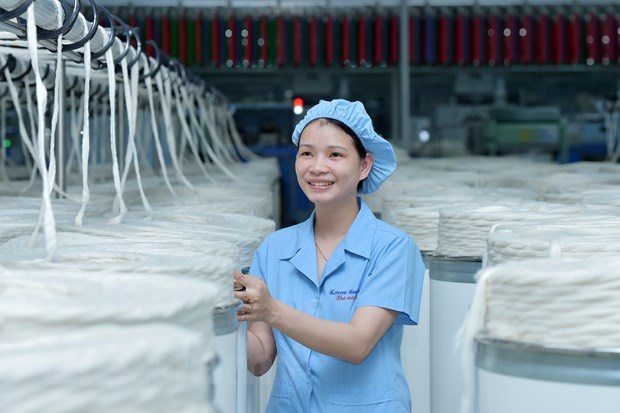Garment-textile sector aims at 40 billion USD in export in 2019
 Vietnam’s garment-textile exports are forecast to reach 40 billion USD in 2019 (Photo: Duc Duy/VietnamPlus)
Vietnam’s garment-textile exports are forecast to reach 40 billion USD in 2019 (Photo: Duc Duy/VietnamPlus)
Hanoi (VNA) – Despite a number of difficulties in the export market, the target of 40 billion USD set from the beginning of the year has gradually become a reality, according the Vietnam National Textile and Garment Group (Vinatex).
The world’s economic panorama with many gray colours have significantly affected Vietnam’s export activities in the past months. However, the sector’s target set from the outset of the year has gradually become a reality.
To understand more about the outcomes of the garment-textile industry, Vietnam News Agency reporters had an interview with Cao Huu Hieu, managing director of the Vinatex.
- Looking back to the two-third path of the year, how do you evaluate Vietnam’s garment-textile export activities?
Mr. Cao Huu Hieu: According to statistics, as of September, the export turnover of the whole sector was estimated at 29.3 billion USD.
Albeit an array of difficulties in the export market over the past time, the figure of 400 billion USD could be achievable by the year’s end.
To achieve the aforesaid outcome, the sector has taken a lot of measures to deal with global economic difficulties.
- What is the biggest challenge that the garment-textile industry has encountered in the past time?
Mr. Cao Huu Hieu: First of all, the difficulties came to the fiber industry. Due to the impact of trade tensions, yarn prices fell strongly in the first months compared to the same period of last year.
In this context, if enterprises do not have appropriate investment plans and take quality as the top priority, they will certainly face bankruptcy.
For Vinatex, right from beginning, the group has defined quality as the most important standard. Therefore, its businesses have been able to overcome difficulties without depending too much on a single market to minimize risks. Currently, many Vinatex’s factories have joined supply chains for textile and fabric to secure certain market shares.
Particularly, the fiber industry has been prospering in recent time with more customers and increasing prices. We hope to see new breakthrough in growth as in the 2016-2017 period.
 Cao Huu Hieu, managing director of the Vietnam National Textile and Garment Group (Photo: Duc Duy/VietnamPlus)
Cao Huu Hieu, managing director of the Vietnam National Textile and Garment Group (Photo: Duc Duy/VietnamPlus)
- As an enterprise with the largest market share in the garment-textile industry, would the market’s difficulties affect Vinatex’s completion of its target set since the beginning of the year?
Mr. Cao Huu Hieu: Despites numerous difficulties, the group has basically completed financial criteria set at the beginning of the year and also recorded slight growth compared to the same period of 2018.
This is a great effort of Vinatex to take effective measures to overcome many challenges in 2019.
Though some trade agreements such as the Comprehensive and Progressive Agreement for Trans-Pacific Partnership (CPTPP) has come into force, and the EU-Vietnam Free Trade Agreement (EVFTA) has been signed, it requires businesses to make a lot of efforts to optimise incentives.
- Many opinions said the Fourth Industrial Revolution will exert a profound impact on the garment-textile sector, especially labour issue. What do you think about this?
Mr. Cao Huu Hieu: The application of technology has been carried out strongly in recent years, especially in the field of garment-textile. Currently, many Vinatex businesses have invested in machines to replace labour-intensive positions and 3D design as well as stages requiring high accuracy.
However, garment is a fashion industry, so the human creativity is very important. In some stages, machines could not replace humans.
A survey of about 150 businesses in the sector showed that job opportunities in the garment industry in the next 10 years remain large.
For the yarn and dyeing sectors, with the fast development of technology, especially the strong automation, these two fields will be under a lot of pressure.
- As there are only two months left, what has the garment-textile sector employed measures to realise the export target of 40 billion USD?
Mr. Cao Huu Hieu: Businesses in the industry are taking all possible measures to boost exports, especially the yarn market, which is recovering from serious impact of trade tensions.
We really hope that with the growth of the yarn sector, plus the stable growth of the garment sector, Vinatex’s businesses will complete their yearly targets in the remainder of 2019, contributing to the sector’s common goal of 40 billion USD.
- How do you evaluate the domestic market? Would there be any breakthroughs compared to 2018?
Mr. Cao Huu Hieu: With the potential of the domestic textile industry, which is estimated at 9 billion USD, I think this is a big game. In addition to the prestigious world brands that have been invested in the past, by 2020, Japan’s Uniqlo brand will also be present in Vietnam.
Given these pressures, Vinatex, apart from the quite successful operation of a fashion centre at 25 Ba Trieu, Hoan Kiem district, will open another centre at 57 Phan Chu Chinh, Hoan Kiem, Hanoi.
In the current context, the Vietnamese garment-textile industry will need to seek an own path with designs suitable to local customers’ preferences to affirm its position in the domestic playground.
Vinatex will focus on studying designs for Vietnamese customers, selecting materials suitable to separate segments in the textile sector to ensure quality, reasonable prices, and competitiveness.
- Thank you so much./.













